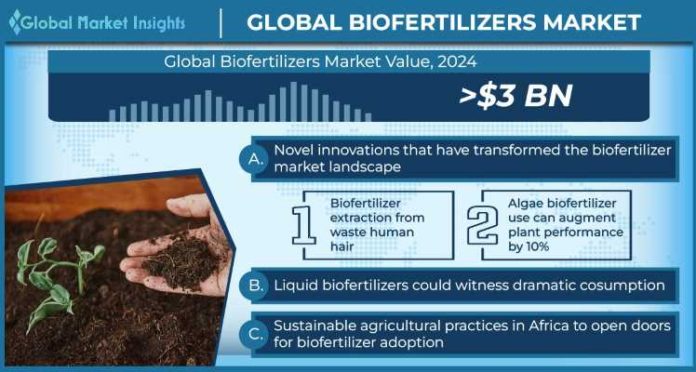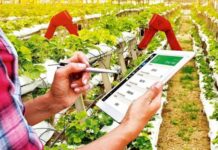The global biofertilizers market is foreseen to grow significantly in the years ahead. With the global population forecast to reach a whopping 9.7 billion by 2050 and food production demand speculated to grow by 60% over the same timeframe, farmers and government entities are re-structuring ways to make arable lands highly profitable.
Different central governments have, over the past few decades, encouraged policies luring farmers into the short-sighted cultivation processes that involved use of increased amounts of synthetic chemicals to improve the yield. And it did pay well in the short-run but declined the quantity and quality of the yield over the years, leaving a notable portion of lands infertile.
This has raised concerns amongst agriculturists and farmers, prompting them to shift to organic ways of producing yields. From a luxury to now being perceived as green and clean food, ‘organic’ has evidently become a buzzword in today’s agriculture industry. Stakeholders are adopting several strategies to make sustainable and organic agriculture mainstream; one of the key ones being the use of biofertilizers, to deliver optimum nutrients to soil and augment the soil potency.
Groundnut farmers in Ghana, for instance, have been advised to make use of the rhizobium biofertilizer created by the Council for Scientific and Industrial Research, Savanna Agricultural Research Institute (CSIR-SARI), to enhance their crop productivity and ensure food security in the region.
Novel innovations that have transformed the biofertilizer market landscape
The global biofertilizers industry, which is anticipated to surpass USD 3 billion by 2024 in value, is currently a significant ground for research and developments, given the product’s increasing value and sales.
- Biofertilizer extraction from waste human hair
It would not be surprising to note that human hair is considered as a waste material in most parts of the world. In 2020, human hair waste was the 372nd most traded product worldwide with a total trade woth over USD 150 million. In this regard, researchers are now channelizing ways to obtain biological fertilizers from the human hair waste.
In 2020, Scientists from Central Salt and Marine Chemicals Research Insitute developed an integrated process through which they have been able to extract biofertilizer from waste human hair. The scientists were able to extract 300 millileters of ionic liquid, along with 360 grams and 200 grams of keratin and melanin respectively.
- Algae biofertilizer use can augment plant performance by 10%
In 2021, Dimiagro announced development of a bioactive extracted from cyanophyta algae. The product developed is known to increase the rooting and growth performance of corn and soybean plants by up to 90%. It contains bioactive component which sends a chemical signal to accentuate the physiological processes in vegetables, leading to increased productivity and vitality.
The company, through this substantial move, publicized its plans to replace fertilizers based on imported algae by initializing its own production unit by 2021 end.
Liquid biofertilizers could witness dramatic cosumption
Many farmers around the globe, due to lack of awareness and shortcomings of dry biofertilizers, are skeptical in adopting the use of agriculturally essential microorganisms. To overcome this challenge, studies are emphasizing on the development and commercialization of liquid biofertilizers which are not only more effective than dry fertilizers in terms of application, but also offer umpteen advantages, such as:
- Potential to enhance health and productivity by reducing use of agro chemicals
- Higher shelf life
- Boast of increased tolerance to adverse temperatures and UV radiations
- Easy handling and reduced storage space
- Enhanced soil structure and water holding capacity
- Cost efficiency
Driven by the superior merits, companies are now foraying into the liquid biofertilizers business space, marking a trend that warrants the industry growth. Amul Dairy in India, for example, inked an MoU with Anand Agricultural University for liquid biofertilizer technology to limit the use of chemical fertilizers in agriculture. The pact not only seeks to promote the market and business of reliable, low-cost liquid biofertilizer manufacturing, but also change farmers’ perception about using synthetic fertilizers excessively.
Sustainable agricultural practices in Africa to open doors for biofertilizer adoption
The food supply and demand gap in Africa is widening, with factors like Russia-Ukraine war and COVID-19 being two of the prime contributors. World Vision report quotes that 1/3rd of Africa’s population was undernourished as of 2020. According to the United Nations, about 50 million people in Eastern Africa are likely to face acute food insecurity by 2022.
To this end, sustainable agricultural initiatives have come as a rescue plan for agriculturists and farmers looking out for better alternatives to increase the soil fertility and crop productivity. Recently, Action-aid Ghana, in its efforts to mitigate the impact of climate change on food production and ensuring food security in the region, announced open collaboration with the University of Energy and Natural Resources. The organization discussed on means of ensuring sustainable agriculture and food security via agroecology where farmers use sustainable interventions for promoting resilient agriculture. These cues would stimulate the sales of biofertilizers in the region, leading to potential market expansion.
What is next for the biofertilizers industry?
Biofertilizers have come a long way from being observed as an alternative to chemical fertilizers to their current stint as nutritional aids for plants, that can mobilize vital growth elements and boost soil health. While biofertilizers are becoming increasingly popular, they still are in the emerging stages of adoption across the emerging economies. Most of the current biofertilizers extensively available in the market are nitrogen-fixing; the demand for phosphate-solubilizing fertilizers is penetrating. The use of biofertilizers in fruits and vegetable applications can be expected to grow exponentially in the forthcoming years subject to the growing consumption of organic fruits and vegetables in developed countries.










Thanks for sharing the awesome blog with us. Want to increase your market trend then you can visit CAGR official website – https://cagrreports.com/
Comments are closed.